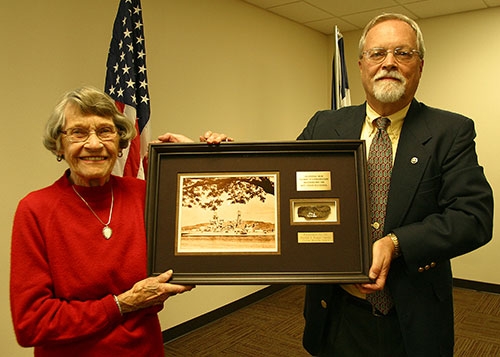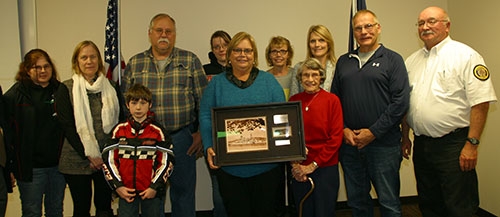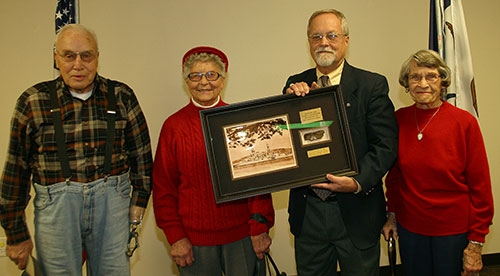You are here
Home ›Regan family donates piece of USS Arizona in honor of local veterans

Jacquelyn "Jac" Regan of Waukon (left) and her son, Dr. Stephen Regan (right), display the memorial they donated in memory of their husband and father, former Waukon pharmacist and military veteran Daniel Regan, at an event held at Robey Memorial Library Tuesday, December 6, the eve of the 75th anniversary of the bombing of Pearl Harbor. The memorial contains a small piece (in the middle on the right side of the memorial) of the actual USS Arizona that was sunk in the bombing attack and remains as part of Pearl Harbor Monument. The memorial was donated to the City of Waukon and local Veterans organizations in honor of two local men, Ensign Lawrence Anderson and Gunners Mate Stanley Teslow, who were serving on the ship at the time of the attack. Photo by Lissa Blake.

Members of the family of Ensign Lawrence Anderson, a Waukon native killed aboard The USS Arizona in the December 7, 1941 attack on Pearl Harbor, are pictured above with Jacquelyn "Jac" Regan of Waukon and Tom Regan of the local American Legion displaying the memorial featuring a photo and an actual piece of USS Arizona. The memorial was donated by the Daniel E. Regan family to the City of Waukon and the local Veterans organizations at a presentation held at Robey Memorial Library in Waukon Tuesday, December 6. Photo by Lissa Blake.

Walter and Lorraine Teslow, brother and sister-in-law of Gunners Mate Stanley Teslow, a Waukon native who was serving on The USS Arizona and survived the December 7, 1941 attack on Pearl Harbor, are pictured above with Dr. Stephen Regan and his mother, Jacquelyn "Jac" Regan of Waukon, displaying the memorial featuring a photo and an actual piece of USS Arizona. The memorial was donated by the Daniel E. Regan family to the City of Waukon and local Veterans organizations at a presentation held at Robey Memorial Library in Waukon Tuesday, December 6, the eve of the 75th anniversary of the attack on Pearl Harbor. Photo by Lissa Blake.
by Lissa Blake
The bombing of Pearl Harbor December 7, 1941 was the moment when everything changed - for the United States, for the rest of the world, and for family and friends of two local veterans.
Waukon native Dr. Stephen Regan spoke to a crowded room at Robey Memorial Library in his hometown Tuesday, December 6 in honor of the 75th anniversary of the Japanese bombing of Pearl Harbor, commemorating that historical event and some local ties to it.
Dr. Regan, a military historian and author, was on hand to present the City of Waukon and area veterans with a small fragment of the USS Arizona (BB 39) in a framed memorial in honor of two Waukon veterans, Ens. Lawrence Anderson and Gunners Mate Stanley Teslow, who served on the ship at the time of its demise 75 years ago. The memorial also includes a photo of USS Arizona, along with an engraved inscription that reads, "Presented by the Daniel E. Regan family Cedar Rapids NLUS."
Anderson died as a result of the attack, but Teslow survived, eventually becoming the first survivor to have his ashes buried with his shipmates on USS Arizona, which still lies at the bottom of the harbor, entombing many of those who paid the ultimate price in that Pearl Harbor bombing.
A few years ago, Congress gave the Navy League of the United States (NLUS) 400 small pieces of the USS Arizona superstructure for memorials. Regan helped the Cedar Rapids Council of the Navy League, where he served as president, obtain three pieces through partnership with the Hilo Hawaii NLUS Council. Regan presented one piece to the Eastern Iowa Veteran’s Museum July 4, 2015 and was determined that Waukon should have one as well in honor of its two veterans who served on the ship and who are now both entombed there.
Dr. Regan’s father, former Waukon pharmacist Daniel E. Regan, served as a Corpsman with the 9th Marines in the Pacific theater during World War II. Dr. Regan's mother, Jacquelyn "Jac" Regan of Waukon, donated the money to make possible the memorial in memory of her late husband. She attended the event, along with members of both Anderson’s and Teslow’s families.
The memorial will now be on display at Robey Memorial Library in Waukon.
NOTHING THE SAME
In his featured talk following the memorial presentation, Dr. Regan said everything in history is connected, and one cannot understand history unless he or she understands the strings that connect it. “Nothing is the same at start as it is at stop,” he said.
Dr. Regan traced strained relations between the U.S. and Japan back to Commodore Matthew Perry’s trip to Japan to force open markets in 1853. He discussed the U.S. government’s early 20th century ban on Japanese immigrants and Japan’s discontent over not being hailed as one of the victors during World War I, even though the country had expressed solidarity with the Allied Forces.
He chronicled Japan’s invasion of Manchuria, its withdrawal from the League of Nations and invasion of China in 1937, as well as Japan’s realization that the only way they could be successful in a war against the United States would be to destroy the American fleet at Pearl Harbor.
THE IMPOSSIBLE HAPPENS
Dr. Regan said although the U.S. had previously participated in war games showing that Japan would be capable of attacking the U.S. fleet at Pearl Harbor, the Navy refused to accept the possibility that it could. “They declared this couldn't happen, because certainly the U.S. would know where the Japanese Navy was,” he explained.
Early the morning of Sunday, December 7, 1941, what the U.S. said could never happen, did. “There were 75 ships in Pearl Harbor at the time: destroyers and auxiliary ships and heavy cruisers,” said Dr. Regan.
Early that morning, the USS Ward had spotted a submarine trying to sneak into the harbor and had dropped depth charges to discourage it. Although USS Ward called in the warning, it was ignored. A short time later, the harbor was attacked.
During his presentation, Dr. Regan used a map of the harbor and placement of many of the ships, and showed dramatic photos of them under attack. He shared many first-hand accounts of the day, including a report that following the bombing of USS Arizona, Teslow had seen Anderson on a stretcher, but was uncertain what had happened to him after that.
A SAILOR RETURNS
Dr. Regan said the average age of the men serving on these ships was 18 or 19. “They were just kids,” he said.
Dr. Regan said because of their youth and the time they spent together, these ships became a fraternity of sorts, and because of that, for decades after the war was over, survivors of the Pearl Harbor attack expressed interest in having their ashes returned to Hawaii for burial.
“Finally a few years ago, Congress voted to allow survivors’ ashes to be interred in the sunken hull. Mr. Teslow was the first to be buried with his shipmates,” said Dr. Regan of Gunners Mate Teslow's burial with his fellow USS Arizona sailors following his passing in 1982.
Dr. Regan said of the 1,500 men who were serving on board USS Arizona, 350 survived. He said all parts of the ship above the water line were removed from the ship for possible salvage, but most of those who died are still on board.
“The memorial is a very stark and serious reminder,” he said.
GOING FORWARD
Dr. Regan outlined a number of mistakes made by both the Japanese and the Americans.
He said America was “too isolationist,” ignored many indicators and underestimated Japan. He said Japan left the dry docks untouched, failed to attack again and did not catch the aircraft carriers or oilers at Pearl Harbor.
He talked about a number of “What if?” scenarios, such as “What if Japan had not attacked Pearl Harbor? Would we have gone to war with Japan? No, we wouldn't have. What if Japan had made a second attack and hit our oiler storage tanks? They didn’t,” he said.
Dr. Regan also asked the rhetorical question, “Could Pearl Harbor happen again?”
“9-11 is a perfect example,” he said, in answer to his own query.
NEVER FORGET
“There are few times in history… turning points where everything changes, from politics, alliances, economics, even religion… This all changed in about an hour and a half on a Sunday morning in a quiet little town, in a quiet little bay in Hawaii,” Dr. Regan said. “What a tremendous moment in history.”
ABOUT DR. REGAN
Dr. Regan is the biographer of Admiral Frank Fletcher (In Bitter Tempest, 1994), and was a participating historian for the book Re-fighting the Pacific War: An Alternative History of World War II (Ed. Jim Bresnahan) that was published by the U.S. Naval Institute in 2011. A frequent contributor to various historical journals, he also writes a monthly column on maritime and nautical affairs.

